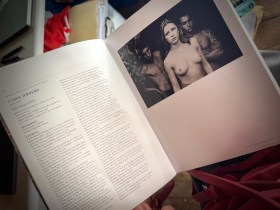Getting a gallery is tough. While London has a pumping art market, there is also no shortage of artists worthy of representation. What that means is that gallery stables are generally full, and getting through the door is by no means an easy feat.
So, when it does happen, most artists don’t want to jeopardise that moment. They will be willing to just sign on the dotted line, and get on with the job. But it is that key word – job – that is the pickle that can taste sour later.
This is a business arrangement, as well as a marriage of values and aesthetics. So you need to don ‘board room attire’ and bring the tough discussion to the table, before you sign anything. And if there is no contract, then this is a good time to ask for that ‘agreement of expectations’ to be put into writing.
What’s in this story:
Communication, communication, communication…
Like any relationship, gallery representation will only succeed if you communicate well. And that foundation should be laid from the start. The gallerist needs to understand very clearly what is important to you in this relationship, and what you want to get out of it. They should also make it very clear what their expectations are for you, as a gallery artist.
Before you sign on, speak candidly off the record with some of the other artists that show with the gallery and, if you can, those who have left. Find out if it is a supportive environment, whether they pay on time, are they aggressive about exclusivity and do they give you enough visibility? These are probably the four main points that come up again and again.
ArtsHub wants to make that process as easy, and as professional as possible, so we have armed you with nine questions that you need to ask. Remember, you have power in this conversation also – you are there because they are interested in you, and you can be guaranteed they have done their research on you.
The 9 questions you need to ask before signing
1. Why do you want me – what do you like about my work?
As with any relationship, you want to know that the attraction is genuine. You want the gallery to ‘get’ what you do, and have a passion for it. It is this very passion that sells your work to collectors and curators. It also means that they will work for you – that they can talk about your work with a connection and eloquence – and, most importantly, are committed in growing a bond with you.
2. Who will be my main contact at the gallery, and how is that managed?
Given the number of artists often represented, a gallery will either divide up the artists among its directors, or will allot certain elements of their representation to certain staff. For example, sales may stay with the director, and marketing may be managed by someone else, while your inventory may be someone else again. You need to be very clear on these chains of command and communication.
You also want to be clear on how much autonomy these staff members have in answering your questions and making decisions, or are they just making light of administration for the director, who always has the final say. You then want to know, how approachable is that director?
3. Can you run me through who pays for what?
All creatives hate talking about money. But this is the one time you need to be clear. Who will pay for the shipping of your work – not only to the gallery, but its return if not sold, and also its insurance and storage? Who will pay for the opening invitations and catering? What about framing and photography? And when it comes to making work for a major museum show, does the gallery help you with upfront costs? What about if you win a major prize – does the gallery take a cut?
Read: 5 tips to alleviate the stress of preparing an exhibition
4. What are your expectations around exclusivity and commissions?
You need to be very clear about the terms of exclusivity that the gallerist expects of their represented artists – simply, are you able to show at another commercial gallery? What about artist-run spaces and independent spaces? What about international galleries, and will the gallery expect a cut on sales abroad?
In terms of commissions, the standard commission is 50%. Ask them to step you through how it works with art consultants, or if a sale is split with another gallery. And what about public art commissions or private commissions, how are these handled?
It is also wise to ask how a discount extended to a client on a sale will impact you? Does it come out of their 50% or yours?
5. What do you expect in terms of sales from my work?
Don’t feel shy to ask them what they expect in terms of sales of your work. They will probably say they will test the waters in a group show first, and then get a feel for the market and where your work sits. That all sounds very abstract.
Especially if they expect a level of exclusivity, you need to communicate to them that you require an income to sustain your practice, so ask them to give you an idea what that may look like, to help you plan and be realistic.
6. What goals do you have for my work – where do you see it going?
You are having this conversation with a gallerist because they see potential in your work. So why not blatantly ask them what they see.
Read: 30 things I learned working in a gallery
7. What guarantee do you have that I won’t get lost in the stable?
Ask them outright – what is the ideal number of artists they represent and how do they ensure that they give each artist’s work the attention it requires? How often can you expect to have a solo exhibition, and then be included in group exhibitions in between?
We all understand there are ‘superstars’ in any gallery’s stable, who are the best sellers and most desired, but what guarantee can they give you that they will work for your career also, given everyone is stretched for time?
8. What about wait lists, and the need to deliver work?
What is the gallery’s expectation of you in terms of delivering new work – how often, and how much? Do they get involved in suggesting what they may like to receive into inventory?
And what about collectors on ‘wait lists’ for work – how is that managed and how much pressure can that put on you creatively? How do they keep that in balance and protect you, should that situation arise?
Read: Why I left my art gallery
9. And you – what ambition do you have for the gallery?
You don’t want to sign on and later find out the gallery is winding down in three years, or pulling back their activities and just working from a back room without exhibitions. It is only fair to know their future plans – this is a marriage of two parties – so ask what their visions and aspirations for the gallery are.
You can be familiar here – how did they start up? Did they ever think they would be where they are now? Do that have a masterplan they are working towards? How did they manage through COVID in terms of artist care? Do they think the market is soft right now, and what is their projection of the market over the next year or so?
The bottom line in any gallery relationship is that you want to be able to trust the other person – to grow with them – and to love being part of that gallery family.


_Encounters-in-Reflection_Gallery3BPhoto-by-Anpis-Wang-e1745414770771.jpg?w=280)


